|
|
|||
|
(Back to Preceding Week; on to Next Week) |
|
NOTE 1: We spent three weeks banding hummingbirds in Costa Rica in early 2008. The following account is for Week Two. Week One is summarized under Alpha Group; we encourage you to examine that account before going further on this page. After reading the Week Two report below, you may wish to view results from Week Three.
NOTE 2: Three more nine-day hummingbird expeditions are scheduled for 2009: 24 January-1 Feb, 3-11 Feb, and 13-21 Feb. For more information see 2009 Hummingbird Expeditions and contact EDUCATION. COSTA RICA HUMMINGBIRDS 2008: WEEK TWO (Krazy '08s Omega) The 12 members of our Krazy '08s Alpha group departed Buena Vista Lodge in Guanacaste Province on 1 February, having just completed the most productive week of hummingbird banding during the four years we've led expeditions to Costa Rica. We took most Alpha team members to the Liberia airport for flights back to the U.S., but two couples opted to rent cars and stay in the country on their own for additional exploration and sightseeing. After bidding adieu to the Week One participants, trip leader Bill Hilton Jr., in-country expert guide Ernesto Carman Jr., and bus driver Guillermo, AKA "Whiskers", drove into downtown Liberia for lunch and to buy a few supplies--particularly a case of ibuprofen, bags of Epsom salts, and a plastic tub in which Fearless Leader could soak his aching ankle--broken the day before during an ill-fated horseback ride (below) to the volcanic spa up at Buena Vista.
All text & photos © Hilton Pond Center; photo above © Glenn Dulmage, Alpha Group Despite his injury, there was work to be done in preparation for 3 February--when more eager folks from the U.S. and Canada would be jetting into Liberia for a second week of Operation RubyThroat activities. Fortunately, we had scheduled 2 February as an "off" day between Weeks One and Two, so Fearless Leader had some time to practice moving about on a pair of crutches lent him by Buena Vista Lodge. (He elected not have a walking cast applied to his ankle, lest it interfere with and complicate the second week of field work. Besides, there was real risk he could pick up an infestation of chiggers in the field--with no way to scratch them inside a plaster cast!) Fortunately, Ernesto brought his car on this year's expedition and graciously served as Fearless Leader's personal taxi service when he had to move any distance at the Lodge. To reiterate, we were in Guanacaste Province (see map, below right) because several years previously Ernesto had encountered relatively high concentrations of Ruby-throated Hummingbirds, Still trying to find the optimal date for observing and banding RTHU, we scheduled our two 2008 expeditions for the last week in January and first week in February. Week One participants--nicknamed "Krazy '08s Alpha"--spent six days in the aloe fields and used mist nets to help capture 58 RTHU, our best one-week total during five expeditions; of these, 36 were males (four adults with full red gorgets, plus 32 still-molting juveniles). We were quite pleased with the Alpha group's industriousness and productivity--especially since they also caught a female hummer we had banded the year before in the same field. This bird (#C51582, above left) was the first in history to confirm that female Ruby-throated Hummingbirds also appear to have winter site fidelity, as did male #C51517 mentioned above. We could hardly wait to see what kinds of discoveries might be made by this year's second group coming in to help catch and band ruby-throats in the aloe fields.
All text & photos © Hilton Pond Center DAY ONE OMEGA (3 Feb): The leadership team (Hilton, Carman, and bus driver Whiskers) got to sleep in a little on 3 February, but then it was off to the airport in Liberia to await arrival of participants from far-off and wintry locales such as Alberta, Canada and Columbus, Ohio. Alexis Dandretta and Steve Gulo of Dover, Massachusetts were first to arrive (above), with Alexis wearing her hometown New England Patriots T-shirt and earrings as Ernesto grabbed the couple's bags.
All text & photos © Hilton Pond Center; photo above © Bob Patton Buena Vista's on-site nature trails, canopy walk, forest water slide, serpentarium, pool, gift shop, and volcanic spa were among optional amenities group members liked to frequent during afternoon free time that followed mornings in the field. (Did we mention how fearlessly five women from the Week Two group prepared for the canopy zip line at Buena Vista? We imagine the photo above would strike fear in the hearts of many professional football players.) Each evening the group gathered in one of the dining halls for orientation, data analysis, and further instructions, or to hear fellow participants talk about their lives, interests, and accomplishments back home.
Week Two participants were diverse and included one repeater and a couple we met at a West Virginia Elderhostel. A few we encountered at public programs we have given, but most knew about Operation RubyThroat through word-of-mouth advertising or from simply stumbling across our work on the Web. None were professional scientists or experienced field assistants, but all had something valuable to offer. The Week two group (above)--known affectionately and forever more as Krazy '08s Omega--included Anne Beckwith (Durham NC), Jo & Rusty Crouse (Columbus OH), Alexis Dandretta & Steve Gulo (Dover MA), Peggy Duszynski (Okotoks, Alberta, Canada--also a member of "The Lucky Sevens" expedition in 2007), Jill McGuire (New Bern NC), Bob Patton (Columbus OH), Kathy Roggenkamp (Chapel Hill NC), Liz Schmid (Kernersville NC, co-owner of the High Point NC Wild Birds Unlimited store that has hosted several of our Hummingbird Mornings weekends in August), and Natalie Smith (Columbia SC). We regret Nan Patton, who was to join us for Week Two, had to cancel at the last minute due to health problems; we trust her husband Bob shared lots of photos and anecdotes (and a limerick or two) when he returned home to Ohio. 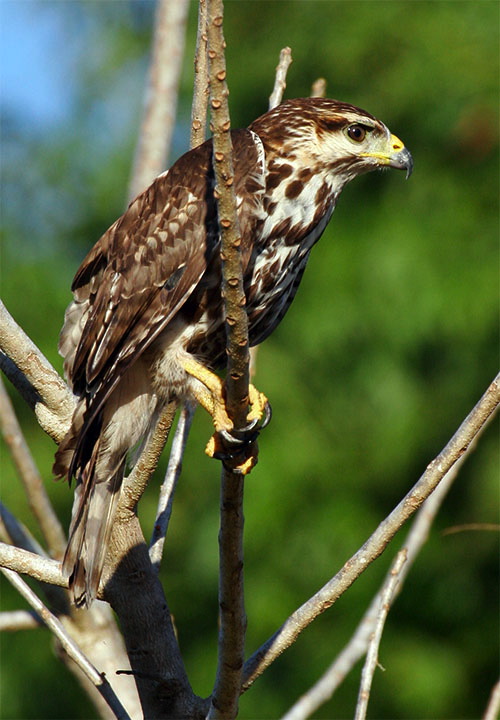
All text & photos © Hilton Pond Center DAY TWO OMEGA (4 Feb): Everyone was up before dawn on 4 February, eager for Week Two's first morning of hummingbird banding and observation. During daily bus rides down the mountain and back we always found time to stop to look at some new animal or tropical plant--such as the immature Gray Hawk, Buteo nitidus, in the photo above. The Scrapbook section at the end of this account includes a sampling of flora and fauna we encountered during our travels--and some we discovered in mist nets intended for ruby-throats.
To provide continuity and a basis for comparison--and with the benefit of back-to-back weeks in the field--we elected to have Krazy '08s Omega repeat the efforts of Krazy '08s Alpha. Like their immediate predecessors, Week Two participants would set up and run mist nets (above) for three consecutive days in Aloe Vera Field #3 (AV3), followed by three straight days in AV4.
We had intended to use exactly the same net lanes from week to week, but during Week Two--for the first time in our four years of hummingbird expeditions--the manager of the aloe plantation decided the time was right to extensively irrigate and harvest some of the crop. Thus, to avoid his workers and jets of water from the radial sprinklers (above), we had to shift a few net positions.
All text & photos © Hilton Pond Center; photo above © Alexis Dandretta Some Omega group participants took great pleasure running through the sprinklers and getting soaked under a hot Guanacaste sun--their clothing dried very quickly in low humidity--but deploying nets where hummingbirds might get wet was not a good idea. Taking wet birds out of wet nets is always problematic and even in warm temperatures could lead to a bird damaging its plumage or succumbing to hypothermia. Rest assured the welfare of birds on our study sites was and always is foremost in our minds--as demonstrated above by Kathy Roggenkamp using her hat to shade the sun from a hummer in a mist net.
All text & photos © Hilton Pond Center; photo above © Bob Patton During Week Two Fearless Leader was especially happy bus driver Whiskers was willing to drive his vehicle as close to the study site as possible. Foot travel on dusty roads and within aloe fields isn't all that hard for most folks, but navigating the same on two crutches wasn't so easy. Fearless Leader is grateful Krazy '08s Omega members cheerfully volunteered to help in every way possible, and that Ernesto took over removing birds from all our widely spaced nets--an anaerobic activity that sometimes ran him ragged. With all this help, however, Fearless Leader was able to sit down at the banding table (above) for long stretches of time without having to move on his injured ankle--probably a very good thing.
On 4 February we did deploy nets at AV3 but had a rather uneventful day. The Omega group captured, banded, and released just five Ruby-throated Hummingbirds--three white-throated females and two immature males with incomplete red gorgets. All these came between 7:36 and 8:06 a.m.; the remaining hours until our 11 a.m. shutdown brought only two non-hummers: A thin-billed Tennessee Warbler (above) and a Baltimore Oriole--both young males. Nontheless, everyone in Krazy '08s Omega was excited over the group's initial morning in the field and no one was disappointed things had gone a little slowly. (Slow is always better on the first day when new folks are just learning the ropes.) It's worth noting that all Ruby-throated Hummingbirds we band in Guanacaste, Costa Rica also get their upper breast or throat adorned with a blue color mark (below left). We mark these birds for several reasons. Incientallly, later on the evening of 4 February, missing member Jill McGuire arrived at Buena Vista Lodge via taxi, the wreck on the bridge in New Bern NC having been cleared enough for her to get to the airport there and fly into Liberia a day behind her Omega colleagues.
All text & photos © Hilton Pond Center DAY THREE OMEGA (5 Feb): Things picked up considerably on Omega group's second day in the field, with 13 ruby-throats banded between 8:06 and 11 a.m. Of those captures, only four were females, one was an adult male with a full red throat, and the rest were incompletely gorgetted young males. We also netted several other non-hummingbird Neotropical migrants, including a mostly brown Indigo Bunting male, three second year Orchard Orioles, yet another young male Tennessee Warbler, and two female Painted Buntings (above) with uniform pale green plumage, conical bill, and complete eye ring. Something else VERY remarkable happened on 5 February when--at 9:25 a.m.--an apparent adult male Ruby-throated Hummingbird with heavy throat molt (below right) became snared in one of the mist nets. As Ernesto extricated the hummer, he noticed a good sign: The bird did not seem to be color marked and therefore was one we had not captured in 2008. When Ernesto examined the bird's legs, however,he noticed something else far more interesting: The bird was already banded! This was great news for several reasons. As mentioned above, last year (2007) we recaptured a RTHU that had been banded as a juvenile male the preceding year. Since ruby-throats are not found in Costa Rica after the first of May, this particular bird must have left the country and returned to the same aloe field a year later as a second year male--making it the first Ruby-throated Hummingbird ever known to demonstrate site fidelity on the wintering grounds. (Site fidelity is well-documented by RTHU on their breeding grounds; we have some at Hilton Pond Center that have returned for as many as five years in a row after banding.) During Week One 2008, the Alpha group added to our understanding of site fidelity by re-netting a RTHU from 2007; this was significant because that bird became the first FEMALE ruby-throat known to be site-faithful in the tropics. Now, thanks to the Omega group, bird #C51571 is equally significant because it was banded as an after second year male in 2007 and returned as an after third year male in 2008--the OLDEST ruby-throat known to show site fidelity within its non-breeding range. This is great stuff!
All text & photos © Hilton Pond Center DAY FOUR OMEGA (6 Feb): Our final day in AV3 was almost as productive as the day previous, with nine ruby-throats banded. There was a noticeable absence of red-throated males; two females and eight young males comprised the tally, bringing the three day running total for Week Two to 28 RTHU. Other netted non-rubythroats from North American breeding grounds were three second year male Indigo Buntings, a second year male Yellow Warbler, three second year Orchard Orioles, and another female Painted Bunting. We also caught what many folks claim is the most colorful songbird in North America--a male Painted Bunting (second year, above and below).
When we finished banding on 6 February, we loaded all our field equipment back onto the bus and headed toward Santa Rosa National Park for an exploration of one of the few remaining expanses of tropical DRY forest left in Guanacaste. This forest has both evergreen and deciduous components; because February is the dry season, many trees had dropped their leaves--allowing a better view of the forest interior and everything from howler monkeys to arboreal termites.
After Santa Rosa, as always, we went on to Junquillal Beach (above), a marine preserve that is a nesting site for various species from Magnificent Frigatebirds to endangered sea turtles. There Omega group members explored diverse maritime habitats; most also took a quick dip in the rather chilly waters of the Pacific Ocean--surrounded by natural beauty (below).
DAY FIVE OMEGA (7 Feb): On our fourth day in the field the Omega group moved from AV3 to AV4, where we unexpectedly had to shift nets as the aloe sprinklers were turned on to "plump up" the aloe before harvest. We could hear farm workers over in AV2, hacking off outer leaves of aloe and placing them in bins they then loaded onto a big flatbed truck. Thankfully, the workers were instructed to stay out of AV4 on mornings when we were trying to run nets, so the Omega group managed to pull in an astounding number of hummers on 7 February--25 ruby-throats, to be exact! Who knows? Maybe aloe worker activity in AV2 sent the hummingbirds toward our nets in ASV4. (See GoogleEarth image, below, of the aloe fields in which we worked in 2008; banding table positions are marked with red dots.)
This banding total of 25 RTHU in one morning was a remarkable piece of work that included 14 second year males and 11 females. Yhere was hardly a moment from 8:07 a.m. until we quit at 11:02 a.m. when there wasn't at least one hummingbird awaiting processing at the banding table. The Omega group's single-day tally was almost as many as the 31 we had captured during the entire 2006 expedition and brought the Week Two number to 53 RTHU banded, surpassing the old record of 51 captured in all of 2006.
All text & photos © Hilton Pond Center It should be noted that one RTHU captured on 7 February was not within AV4 but adjacent to it--in a new net in the woods behind the banding table. We deployed this net in a patch of red blossoms borne by what we believe is Aphelandra scabra (above), a member of the Acanthus Family (Acanthaceae) that has no common name of which we are aware. A net in this grove also caught four RTHU during Week One 2008. In the midst of all this hummer action in AV4, we also netted four Orchard Orioles, two Tennessee Warblers, and our first Costa Rican encounter with a buffy-faced Swainson's Thrush (below).
DAY SIX OMEGA (8 Feb): After their blockbuster performance in the field on 7 February, a justly proud Krazy '08s Omega group was chomping at the bit to get back to the aloe plantation for a second day in AV4. Once there we could see plenty of ruby-throats--although few were color marked--and the group managed to capture 15 new ones (two adult and six juvenile males, plus seven females). With 68 birds to their credit by the time we closed nets at 11 a.m., the Week Two field workers had eclipsed Week One's impressive record of 58--and they still had one more day to go. Lest we forget, four more Tennessee Warblers were also captured on 8 February.
DAY SEVEN OMEGA (9 Feb): On their final day at AV4, Crazy '08s Alpha brought to a close their week of running nets in the aloe fields by capturing nine more Ruby-throated Hummingbirds (five females and four second year males). Let the record show that their 77 RTHU set a new standard for productivity in Guanacaste and--combined with the 58 birds from Week One--brought the grand total to 135 ruby-throats banded by Operation RubyThroat in Costa Rica during a 16-day period in 2008. On 9 February the Omega group also netted six more Orchard Orioles, Two Tennessee Warblers, and another Costa Rica first for us--a Northern Waterthrush (above), a rather squirmy bird that was difficult to photograph. Compare this warbler with the bird in the photo just before it and you can see why it's called a "waterTHRUSH."
Following a morning in the field, the Omega group boarded the bus for a ride into Liberia, where we gathered at a local Chinese restaurant for our traditional seafood feast. Many participants elected to go with one of the house specialties--a "locally caught" Red Snapper (size grande)--whose name undoubtedly comes from the fish's rather imposing dentition (above). Once the meal was finished, folks had a few hours for a leisurely stroll through the town plaza and for shopping at small shops--the majority of which appeared to sell women's shoes.
On the way back to Buena Vista Lodge we stopped at "The Wall," an imposing limestone cliff created by a fast-moving mountain stream. Group members including Anne Beckwith (above) were impressed by this rock face--home to epiphytic bromeliads, orchids, cacti, as well as numerous species of ferns, mosses, and lichens. Unlike many locations in Costa Rica, such plants are relatively uncommon in Guanacaste because most of the province is so arid. Moisture from the stream and shade provided by "The Wall" make this spot a true oasis. DAY EIGHT OMEGA (10 Feb):
All text & photos © Hilton Pond Center When we got to Canas Dulces--home of the Aloe Vera fields--we tipped our hats at local citizenry who were walking to church and took a lingering glance at a magnificent Pink Poui, Tabebuia rosea (above), blooming profusely in a nearby pasture. From there, Whiskers turned south on the Pan American Highway and cruised into the international airport at Liberia. At the airport, throngs of ticos with baggage carts stormed our bus, but stalwart members of Krazy '08s Omega--tempered from six days of carrying net poles, rebar, field chairs, mallets, banding tools, and all sorts of other equipment--opted to tote their own luggage. Now that they were seasoned international travelers, they easily made their way through paying the exit tax and then smiled sweetly at security guards who must have wondered exactly why one experienced group member from Canada was checking a suitcase containing nothing but 15 one-pound bags of Ernesto's Cafe Cristina coffee.
After hugs, a final wave from Nat Smith (above), and perhaps a tear or two, the Omega group disappeared into the airport interior . . . Whiskers sped off in the bus toward his family near San Jose . . . and Fearless Leader climbed gingerly into Ernesto's car--now laden with all those net poles and field gear--for a ride to downtown Liberia. There the two had lunch and went to the local bus station to pick up Ernie Carman Sr. (Ernesto's dad) and Elaida Villanueva Mayorga (Ernesto's girlfriend and a Year One expedition veteran). At that moment began Week Three of Operation RubyThroat's 2008 Hummingbird Expedition to Costa Rica . . . but that's another story we'll unfold in next week's installment. KRAZY '08s OMEGA GROUP (Week Two) RESULTS During six days of field work in early February 2008, Costa Rica, Krazy '08s Omega caught a remarkable total of 77 Ruby-throated Hummingbirds--19 more than a new one-week high set by their immediate predecessors in the Alpha 2008 group. The two groups' 135 RTHU banded in 2008 even exceeded the COMBINED total of 97 birds banded during all four Operation RubyThroat midwinter expeditions to Guanacaste in 2004-2007. (NOTE: Prior to 2008 groups had three or four days in the field while this year's had six each. The two groups during Year One also worked in different locales near but not in the aloe fields.)
All text, photos & tables © Hilton Pond Center As shown by Table 1 (above), during Week Two more RTHU males (45) were banded than females (32). The 42 males with incomplete red gorgets were youngsters that must have hatched in 2007 in the U.S. or Canadian breeding grounds, Three males banded in 2008 with fully red throats also might have hatched in 2007 and simply had a faster molt rate than their fellow males, but they also could have hatched prior to 2007; therefore, they were classified as After Hatch Year (AHY). Female RTHU (below) have white throats as juveniles AND as adults, so ageing them is not as definitive. All these females must have hatched at least the summer before (2007); they, too, are defined as AHY birds; in reality, they could have been older.
If we refer again to Table One and lump our Week Two 2008 banded ruby-throats by sex rather than age AND sex, we see Crazy '08s Omega helped net 45 males (58.4%) but only 32 females (41.6%), roughly a 3:2 male:female ratio. (The ratio was even more skewed in AV3, where males outnumbered females 2:1.)
All text, photos & tables © Hilton Pond Center In the 2008 combined totals from Weeks One and Two (see Table 2 above), there are entries for a fourth age/sex category: After Second Year Male (ASY-M). These three birds, captured by the Alpha group, provided one additional hint as to their age. Here's how: RTHU go through a complete molt on the wintering grounds, replacing all body plumage (including the throat) and all wing and tail feathers. Curiously, when a "juvenile" RTHU male brings in his first adult plumage, the adult primary wing feathers are significantly SHORTER than the juvenile primary wing feathers they replace. Thus, when we measure the wing chord of a juvenile male RTHU, it usually falls in the range of 40-42mm, while the typical adult male's wing measures about 36-39mm. All three males we classified as ASY had OLD, faded primaries that measured in the 36-39mm range of adults, so we knew these birds had to be at least two years old, i.e., they hatched in 2006, or earlier, hence After Second Year. (Based on our work with RTHU that have returned to Hilton Pond Center in later years, it appears females of the species also have shorter wing chords from juvenile to adult, but because of a greater range in measurements---40-46mm--and possible overlap, we're not as confident in using wing chord to age females.)
All text & photos © Hilton Pond Center In the photo just above, an adult male is bringing in a new #7 primary, but the three outermost primaries (8-10) are old and faded AND the wing chord is less than 39mm--confirming this as an After Second Year bird. (Don't be alarmed if you have to read this explanation several times; ageing birds is a concept about which experienced banders sometimes have to think twice. Even though the scheme is complicated, it really does make sense and is worth the effort to learn it; knowing the age of banded birds gives us a more complete understanding of the population make-up for any given species.) Wing molt, by the way, is not something one would normally observe on RTHU in North America--except in those relatively few birds that overwinter here, primarily in Gulf and Atlantic Coast states. Although we tried to minimize variables between Weeks One and Two to allow for better comparisons, external factors--and a few executive decisions--interfered with our "control." For one, the aloe plantation manager's desire to irrigate AV4 heavily during Week Two meant we had to move several nets from spots where we had deployed them in Week One. In addition, to maximize capture numbers, we elected to use two more nets than usual on the last two days in the field during Week Two and intentionally placed them in spots where participants had observed concentrations of ruby-throats. Even so, there are apparent similarities between Week One and Two, particularly the higher percentages of male RTHU from field to field and from week to week. In the combined totals for both weeks (see Table 2, above), we netted 81 males (60%) and 54 females (40%), a final ratio of almost exactly 2:1. We were pleased with and proud of the intensive field work conducted by all 11 Krazy '08s Omega group members--especially under difficulties resulting from Fearless Leader's serious ankle injury. The group made a memorable and truly meaningful contribution to Operation RubyThroat's on-going efforts to describe and understand Ruby-throated Hummingbirds in the tropics where these little migrants are poorly studied--even though that's where "our" ruby-throats spend the OTHER half of the year. All text & photos © Hilton Pond Center
KRAZY '08s OMEGA SCRAPBOOK In addition to banding more Ruby-throated Hummingbirds in Week Two than ever before, we also netted a great many Neotropical migrants and resident Costa Rican birds. Thus, our Krazy '08s Omega scrapbook is considerably extensive. We hope you'll enjoy the following images of people, places, and wildlife.
All text & photos © Hilton Pond Center Aloe Vera is a stemless, rosette-like plant with succulent sword-shaped leaves armored with small spines; a member of the Lily Family (Liliaceae), it originated in North Africa but is cultivated commercially in dry areas of Central America--as well as in California, Florida, and Texas. Thus, the relationship between Aloe Vera and Ruby-throated Hummingbirds (second year male, above) is a bit convoluted. After all, ruby-throats--a species native to the Western Hemisphere--historically spent winter months in Costa Rica feeding on native flora such as Jocote trees and False Vervain. Sometime during the last century, landowners imported and planted non-native Aloe Vera that today is harvested for its juice--some of which is exported to Europe to be turned into health and beauty products that in turn are sent back for sale in the U.S. We find it odd that the current Costa Rican mecca for ruby-throats seems to be fields of non-native Aloe Vera in Guanacaste Province, where abundant aloe flowers may actually be enhancing the species' winter survival. We should add that despite the easy availability of aloe nectar, we still saw many Ruby-throated Hummingbirds feeding on blossoms of native vines, trees, shrubs, and forbs. (Next week's final installment about our 2008 Costa Rica field work will include photos of and details about other RTHU forage plants.)
Week Two of 2008 was the first time in four years we had seen any significant human activity in the Aloe Vera fields at Canas Dulces. To minimize the effects of Guanacaste heat, field workers began harvesting at 6 a.m. when the sun was low and morning haze (above left) provided a cooling effect. We were gratified to learn the workers harvested only the outermost leaves of aloe plants (below right), stacking them in plastic trays they then loaded onto a flatbed truck or trailer.
Succulentous aloe stems were removed with a sharp knife that was much shorter than the two-foot machete ticos often carry into the field. Because the main plant is not significantly damaged by harvest of its outer leaves, aloe farming can be called a sustainable agricultural activity. Furthermore, some aloe farms are truly organic, in part because aloe is resistant to many diseases and insects (eliminating pesticides) and Costa Rica's rich volcanic soils provide sufficient nutrients (minimizing the need for chemical fertilizers).
Jill McGuire, who works with public radio stations in eastern North Carolina, brought along a nifty little digital recording device with the hope of producing for broadcast an audio postcard about our Guanacaste expedition. In the photo above Jill is capturing a few sound bites from a Ruby-throated Hummingbird in a mesh lingerie bag--a safe way to temporarily hold most birds during banding operations.
All text & photos © Hilton Pond Center At first glance you might have wanted to call the bird above a Common Yellowthroat, Geothlypis trichas--a Neotropical migrant that is indeed found within Guanacaste Province in winter--but then you'd only be half right. It's actually a male Gray-crowned Yellowthroat, G. poliocephala, a year-round Costa Rican resident of brushy fields.
Initially we were quite surprised to capture so many Orchard Orioles and Baltimore Orioles in the aloe fields where hummingbirds also hung out. It made sense, however, in that orioles are nectar eaters and actually can be attracted to orange-colored sugar water feeders designed for them. Based on plumage characteristics, we determined the bird above was an adult female Baltimore Oriole, Icturus galbula, a Neotropical migrant that should be winging its way northward by early May at the latest.
All text & photos © Hilton Pond Center We saw several kinds of lizards in Guanacaste Province, the largest being a five-foot-long Black Iguana, Ctenodon similis (above), perched on a rock along the road between Buena Vista Lodge and the aloe fields. Ctenodons look slow, but their long hind toes and claws can dig in and propel them forward when avoiding potential danger.
Much, much smaller than the Black Iguana was a five-inch long unidentified anole (above) with a long, spiny tail and hanging head-down on an aloe stalk. Like Ruby-throated Hummingbirds, lots of small insects such as beetles and stingless bees are attracted to aloe flowers, so the anole may have been lurking in the shadows until its next meal came close enough to grab.
Small lizards weren't the only organisms we saw perched on aloe flower stalks in Guanacaste. These two unidentified dragonflies (above) were taking a break from their mosquito-chasing duties one morning in Aloe Vera Field #3.
All text & photos © Hilton Pond Center On our trip to Santa Rosa National Park we saw something familiar to most folks from eastern North America: A female White-tailed Deer, Odocoileus virginiana, crossing the road (above). Trailing her and seen less often was a spotted, gangly legged fawn--undoubtedly newborn and barely beginning to get its balance. Adult white-tails are among the largest mammals found in Costa Rica.
If you catch a lot of hummingbirds, sooner or later you will find one that has some sort of imperfection. That was the case with one juvenile Green-breasted Mango, Anthracothorax prevostii (above), whose lower mandible bore a bulbous growth at its base. We suspect this was avian pox, a viral disease we occasionally seen on bills of young birds at Hilton Pond Center. Although the growth is unsightly, we doubt it will have lasting effect on the mango; we've recaptured several birds that had pox when we banded them but that survived until later years.
The female Canivet's Emerald, Chlorostilbon canivetii (above left), which superficially resembles a female Ruby-throated Hummingbird, was the smallest hummer we captured during our mist net operations in the aloe fields. Her prominent facial markings--plus the electric blue bands on the underside of her outermost tail feathers--easily separated her from ruby-throats.
All text & photos © Hilton Pond Center Each evening at 5 p.m., members of Krazy '08s Omega gathered at Mirador, a lookout at Buena Vista from which we could gaze due west toward the sun setting over the distant Pacific Ocean. Every sunset was worth watching, but some such as the one above were even better than others--especially when photographed with a long telephoto lens.
Although Costa Rica sunsets were always worth watching, sometimes it was just as scenic to turn around and look east toward Rincon de la Vieja--the volcanic mountain that towered over Buena Vista Lodge. In the photos above and below, huge storm clouds were roiling up beyond the volcanic ridge--a sure sign it was raining hard on the Caribbean side of the Cordilleran Highlands. (If you look hard, you may even find a faint rainbow in the photo above.)
Rain from the clouds in these two photos never made it to the Mirador lookout, but that wasn't the case in late December 2004 when we brought our first group to Guanacaste. That year we had rain and deafening high winds almost every night--even though the precipitation always petered out before reaching our study site in the aloe fields down the mountain less than ten miles to the southwest.
All text & photos © Hilton Pond Center If during Week One 2008 our most photogenic hand-held bird was a Blue-crowned Motmot we picked up after it bounced off a picture window, then surely the bird in the photo above was the star of Week Two. In-hand is a male Long-tailed Manakin, Chiroxiphia linearis, that hit one of the nets in Aloe Vera Field #4. Manakins--of which there are eight species in Costa Rica--are placed in their own Family, the Pipridae.
In the words of Garrigues and Dean (The Birds of Costa Rica, 2007), "The males perform courtship displays that vary from subtle to sublime." Among Long-tailed Manakins--with their scarlet crowns, sky-blue backs, and exceedingly long "tail" feathers--courtship behavior is carried out in a "lek," i.e., a communal area where two or three males jump and gyrate in a dance competition intended to attract the attention of the much less conspicuous, shorter-tailed female (below).
Curiously, male Long-tailed Manakins collaborate and sing different parts to a song; eventually one bird gets to mate, but it's always the same dominant male that copulates with the female. Ornithologists wondered why the junior male would continue to cooperate in the dance with no immediate hope of passing on his genes; it turns out long-term studies revealed some male pairs stay together for as long as ten years until the dominant male dies or leaves and the remaining male--after years of practice as a back-up--becomes "lord of the lek."
The Omega group actually caught two different Long-tailed Manakin males at AV4 during the week. One of them--possibly a dominant individual--had a well-developed cloacal protuberance (above). With internal gonads that would cause sperm cells to die from a bird's high body heat, male birds have evolved with a way to store sperm in a cooler area "outside" the body. During peak breeding, the outer rim of the cloaca swells from an accumulation of sperm and keeps the cells right where they need to be for cooling . . . AND for quick copulation.
All text & photos © Hilton Pond Center After being accustomed to just Mourning Doves around Hilton Pond Center, we're always amazed at how many kinds of pigeons and doves there are in Costa Rica; up to 19 species might be encountered within the country's borders. Guanacaste Province has its share of members from this family (Columbidae), including the chunky, 11" White-tipped Dove, Leptotila verreauxi (above).
The White-tipped Dove is named for pale tips of its outer tail feathers (above). This species is similar in appearance to other Leptotila species but can be differentiated by a patch of bright blue bare skin that surrounds the eye.
Many doves make a whistling sound with their wings when they fly, and the White-tipped Dove is no exception. This species' whistle is especially noticeable, however, no doubt because of the unusual configuration of the primary feather on the lead edge of its wing (above).
All text & photos © Hilton Pond Center One of our favorite phrases (an original one, we blushingly admit) is: "Never trust a person too lazy to get up for sunrise, or too busy to watch a sunset." On days we worked in the aloe fields, Krazy 0'8s Omega participants were awake in time to see the sun coming up, and most of them elected to be at Mirador lookout at dusk. By a quirk of the celestial calendar, one evening during Week Two 2008 the group got to see a brilliant sunset followed shortly thereafter by this rather spectacular setting of the crescent moon (above). It's not often you get a "twofer" like this, so we're glad the Omegas weren't too busy to watch it.
Although Guanacaste Province is exceptionally dry in February, there are numerous spring-fed streams flowing through the landscape; a few of these rivulets were close to Aloe Vera fields where we worked. Despite this proximity of water, we were surprised one morning to capture a Green Kingfisher, Chloroceryle americana (above), in one of our hummingbird nets. This 7" bird was quite a bit smaller that the 13" Belted Kingfisher, Ceryle alcyon, a more-familiar U.S. species that migrates to Central America in winter. Despite the size difference, the Green Kingfisher still had that big head and long, straight, dark bill associated with members of its family (Alcedinidae). However, unlike the Belted Kingfisher--in which the FEMALE is more brightly adorned with her blue and orange belly bands--it is the MALE Green Kingfisher that bears a bright rusty chest.
In the hand the Green Kingfisher's small crest was not extended, but we did get to see something interesting when we examined the bill up close. What looked at first like little white flecks on the upper mandible (above) turned out to be scales from a fish. Had we collected these and examined them under a microscope we might have determined which fish species had been the entree for the kingfisher's most recent meal.
All text & photos © Hilton Pond Center Parrots are among the favorite birds for most folks who visit Costa Rica, so the Omega group was pleased on their final day to be able to see two species. The 10" White-fronted Parrot, Amazona albifrons (above), posed on a roadside fence post just long enough for group members to snap a photo or two.
Omega participants--like their immediate predecessors in the Alpha Group--were enchanted by one particular pair of Costa Rica psittacines: Aptly named Yellow-naped Parrots, Amazona auropalliata (above). These are 14" birds that seem to be rebounding from a precipitous population decline brought about by overcollecting for the pet trade. These parrot in the photo apparently was preparing to nest in an old woodpecker hole in a dead-standing palm tree. We looked for this pair each day as we drove along the road to and from the aloe study site; most days we were disappointed to see neither, but upon occasion both birds perched in view and serenaded us with their raucous calls.
When they weren't putting up nets, scribing data at the banding table, or performing other specific tasks, Krazy '08s Omega group members had two main responsibilities: 1) To watch Ruby-throated Hummingbirds feeding on aloe or other flowers while noting whether any of the hummers were color-marked; and, 2) To enjoy their time in Costa Rica by taking time to look at every animal, plant, and habitat that piqued their individual or collective interest. We're pleased to report the participants were more than eager to comply with both of these assignments. We were deeply grateful for the conscientious and productive for the work of Krazy '08s Omega, especially in a year when physical infirmity made field work so difficult for the trip leader. May all of them be blessed with fond memories of their days in Costa Rica, from Guanacaste hummingbirds to high country sunsets.
All text & photos © Hilton Pond Center NOTE 1: We spent three weeks banding hummingbirds in Costa Rica in early 2008. The account above is for Week Two. Week One is summarized under Alpha Group. You may also wish to view results from Week Three. NOTE 2: Three more nine-day hummingbird expeditions are scheduled for 2009: 24 January-1 Feb, 3-11 Feb, and 13-21 Feb. For more information see 2009 Hummingbird Expeditions and contact EDUCATION.
Comments or questions about this week's installment?
Thanks to the following fine folks for recent gifts in support of Hilton Pond Center for Piedmont Natural History and/or Operation RubyThroat: The Hummingbird Project. Your tax-deductible contributions allow us to continue writing, photographing, and sharing "This Week at Hilton Pond." (Please see Support if you'd like to make a gift of your own.)
IMPORTANT NOTE: If you ever shop on-line, you may be interested in becoming a member of iGive, through which nearly 700 on-line stores from Barnes & Noble to Lands' End will donate a percentage of your purchase price in support of Hilton Pond Center and Operation RubyThroat. For every new member who signs up and makes an on-line purchase iGive will donate an ADDITIONAL $5 to the Center. Please sign up by going to the iGive Web site; as of this week, 117 members have signed up to help Hilton Pond Center. It's a painless, important way for YOU to support our work in conservation, education, and research. "This Week at Hilton Pond" is written & photographed You may wish to consult our Index of all nature topics covered since February 2000. You can also use our on-line Hilton Pond Search Engine at the bottom of this page. For a free, non-fattening, on-line subscription to |
|
Make direct donations on-line through
Network for Good: |
|
|
LIKE TO SHOP ON-LINE?
Donate a portion of your purchase price from 700+ top on-line stores via iGive: |
|
|
Use your PayPal account
to make direct donations: |
|
| The highly coveted Operation RubyThroat T-shirt --four-color silk-screened--is made of top-quality 100% white cotton--highlights the Operation RubyThroat logo on the front and the project's Web address (www.rubythroat.org) across the back.
Now you can wear this unique shirt AND help support Operation RubyThroat: The Hummingbird Project and Hilton Pond Center. Be sure to let us know your mailing address and adult shirt size: Small (suitable for children), Medium, Large, X-Large, or XX-Large. These shirts don't shrink! Price ($21.50) includes U.S. shipping. A major gift of $1,000 gets you two Special Edition T-shirts with "Major Donor" on the sleeve. |
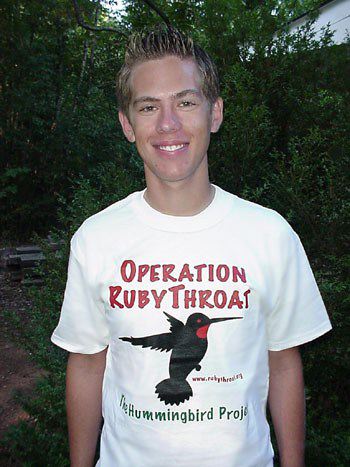
Need a Special Gift just in time for the Holidays? (Or maybe you'd like to make a tax-deductible donation during 2007) If so, why not use our new handy-dandy on-line Google Checkout below to place your secure credit card order or become a Major Donor today? |
|
|
|
|
SPECIES BANDED THIS WEEK: * = New species for 2008 WEEKLY BANDING TOTAL NONE THIS WEEK; IN COSTA RICA (see write-up above) 0 species 0 individuals YEARLY BANDING TOTAL (2008) 8 species 109 individuals 27-YEAR BANDING GRAND TOTAL (since 28 June 1982) 124 species 50,276 individuals
|
OTHER NATURE NOTES OF INTEREST
--The closest we could come to finding a Groundhog (AKA Woodchuck or Whistlepig) was an Agouti, Dasyprocta spp., a Central American rodent with long rear legs that jack up its hindquarters like a street 'rod. These two-foot-long diurnal frugivores are related to Guinea Pigs. Being tropical animals, Agoutis are not likely to be very good at forecasting weather in the continental U.S.
|
|
|
|
(Back to Preceding Week; on to Next Week) Up to Top of Page Back to This Week at Hilton Pond Center Current Weather Conditions at Hilton Pond Center |
 You can also post questions for The Piedmont Naturalist |
Join the |
Search Engine for |
|
|
LL Bean Coupons

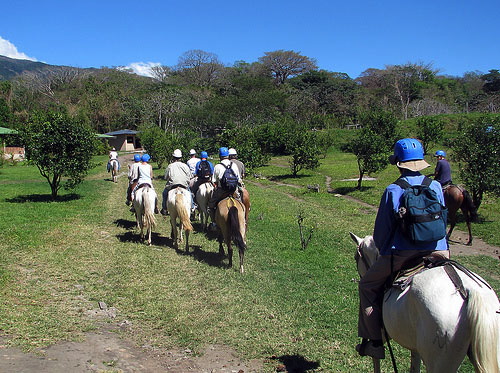
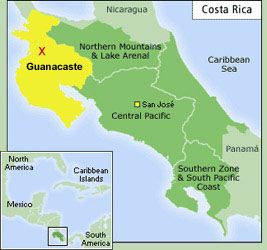 Archilochus colubris, feeding in Aloe Vera fields just north of Liberia. After we discovered (with surprise) that our first expeditions in December 2004 and early January 2005 were "too early"--the aloe wasn't yet in full bloom and we trapped and netted just 15 RTHU in 16 days--we returned in LATE February 2006 and banded 51 ruby-throats. None of the birds that year were adult males; we surmised they had already departed by then for spring migration back to North America. Thus, in 2007 we journeyed south in EARLY February; we caught just 31 birds but six were adult males. (The "Lucky Sevens" also netted bird #C51517, a male that had been banded one year previously in the same aloe field; this bird was the first-ever record of a Ruby-throated Hummingbird showing site fidelity on its wintering grounds in the tropics--just as RTHU do at Hilton Pond Center and other locales within their breeding range in the U.S. and Canada.)
Archilochus colubris, feeding in Aloe Vera fields just north of Liberia. After we discovered (with surprise) that our first expeditions in December 2004 and early January 2005 were "too early"--the aloe wasn't yet in full bloom and we trapped and netted just 15 RTHU in 16 days--we returned in LATE February 2006 and banded 51 ruby-throats. None of the birds that year were adult males; we surmised they had already departed by then for spring migration back to North America. Thus, in 2007 we journeyed south in EARLY February; we caught just 31 birds but six were adult males. (The "Lucky Sevens" also netted bird #C51517, a male that had been banded one year previously in the same aloe field; this bird was the first-ever record of a Ruby-throated Hummingbird showing site fidelity on its wintering grounds in the tropics--just as RTHU do at Hilton Pond Center and other locales within their breeding range in the U.S. and Canada.) 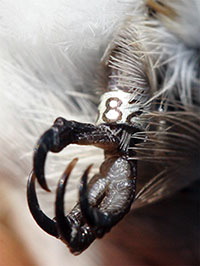
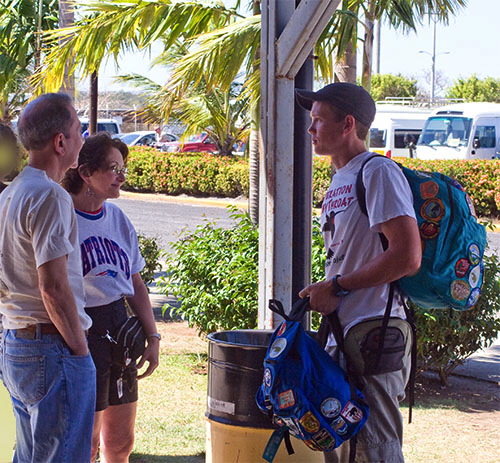
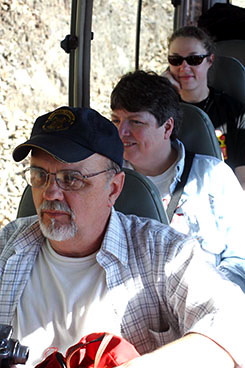 (We didn't find out until two days later the Patriots didn't do quite as well as Alexis might have wished in that night's Super Bowl.) Shortly thereafter a big jet from Atlanta brought in almost everyone else. Notably absent was Jill McGuire from coastal North Carolina; seems there was an accident on a bridge between the airport and her home in New Bern, and she missed her flight completely. Despite this misfortune, we gathered the rest of the newly arrived group members, treated them to a lunch buffet in the Liberia airport, transferred their luggage--all of which HAD arrived, boarded the sleek and shiny air conditioned microbus (above right), and headed up the road toward Buena Vista Lodge. The Lodge, a former cattle ranch on 2,000 acres halfway up Rincon de la Vieja volcano, is a great place to stay--what with breathtaking scenery, abundant birds and other wildlife, tasty food, comfortable cabins, and private bathrooms complete with hot and cold running water (i.e., showers!).
(We didn't find out until two days later the Patriots didn't do quite as well as Alexis might have wished in that night's Super Bowl.) Shortly thereafter a big jet from Atlanta brought in almost everyone else. Notably absent was Jill McGuire from coastal North Carolina; seems there was an accident on a bridge between the airport and her home in New Bern, and she missed her flight completely. Despite this misfortune, we gathered the rest of the newly arrived group members, treated them to a lunch buffet in the Liberia airport, transferred their luggage--all of which HAD arrived, boarded the sleek and shiny air conditioned microbus (above right), and headed up the road toward Buena Vista Lodge. The Lodge, a former cattle ranch on 2,000 acres halfway up Rincon de la Vieja volcano, is a great place to stay--what with breathtaking scenery, abundant birds and other wildlife, tasty food, comfortable cabins, and private bathrooms complete with hot and cold running water (i.e., showers!).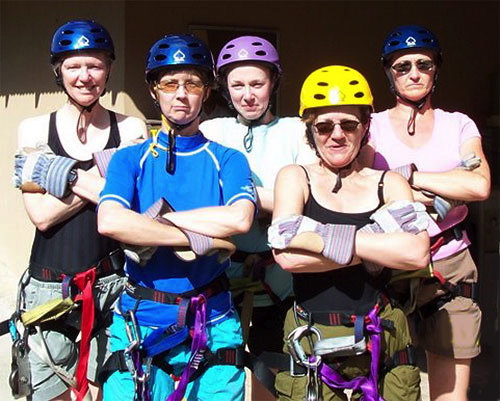
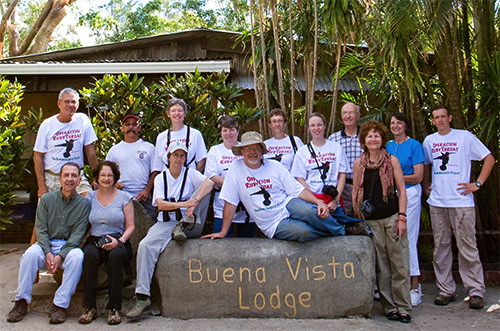
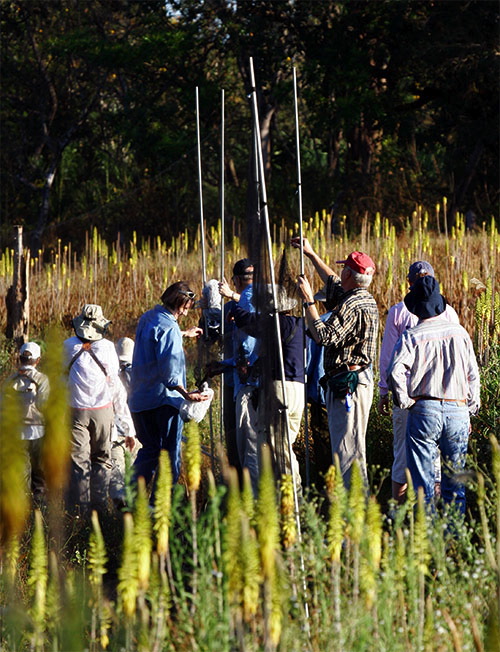
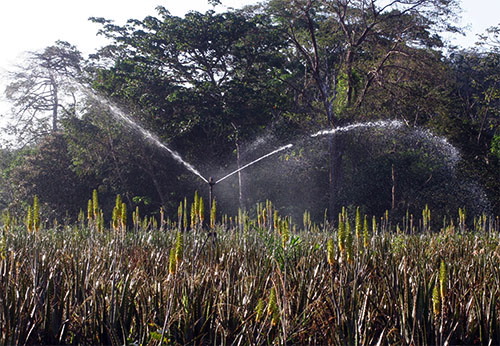
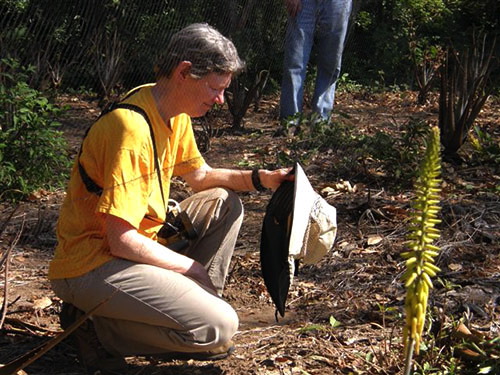
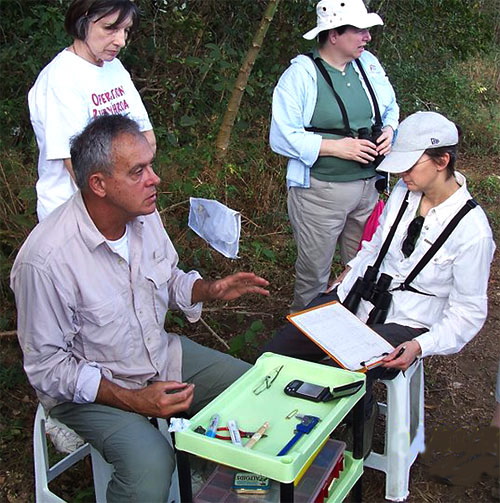
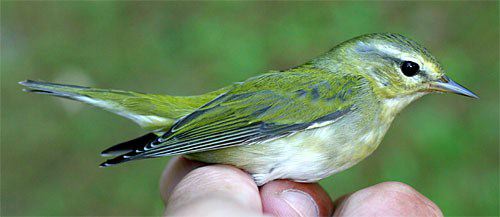
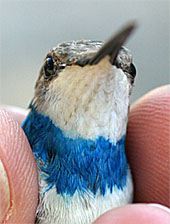 For one, the dye allows us to make observations of banded birds after they are released. (We've learned through the years that after color marking the birds apparently move away from the banding area, at least temporarily.) The color mark also lets us know quickly if a bird was banded recently and facilitates quicker release after the band number is looked up and the recapture info is recorded. Third, there's always the possibility a blue-marked RTHU we band in Costa Rica will show up during spring migration back in the U.S. or Canada. If this ever happens by all means let us know immediately, for it very well could be the first Ruby-throated Hummingbird banded in the tropics and later encountered in North America.
For one, the dye allows us to make observations of banded birds after they are released. (We've learned through the years that after color marking the birds apparently move away from the banding area, at least temporarily.) The color mark also lets us know quickly if a bird was banded recently and facilitates quicker release after the band number is looked up and the recapture info is recorded. Third, there's always the possibility a blue-marked RTHU we band in Costa Rica will show up during spring migration back in the U.S. or Canada. If this ever happens by all means let us know immediately, for it very well could be the first Ruby-throated Hummingbird banded in the tropics and later encountered in North America.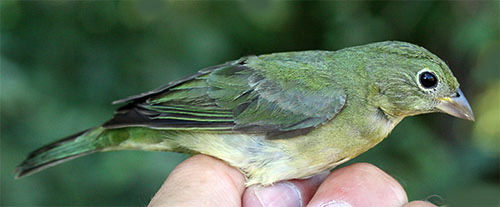
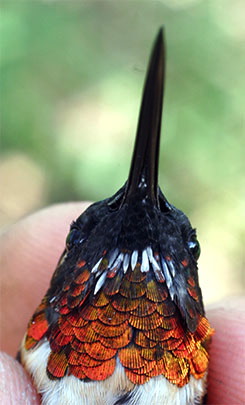 When Ernesto brought this hummer to the banding table we quickly read its band--C51571--and looked it up in our records. Wonder of wonders, this ruby-throat had been captured and banded on 4 February 2007; we had just caught it exactly ONE YEAR AND ONE DAY later in the same Aloe Vera field!
When Ernesto brought this hummer to the banding table we quickly read its band--C51571--and looked it up in our records. Wonder of wonders, this ruby-throat had been captured and banded on 4 February 2007; we had just caught it exactly ONE YEAR AND ONE DAY later in the same Aloe Vera field!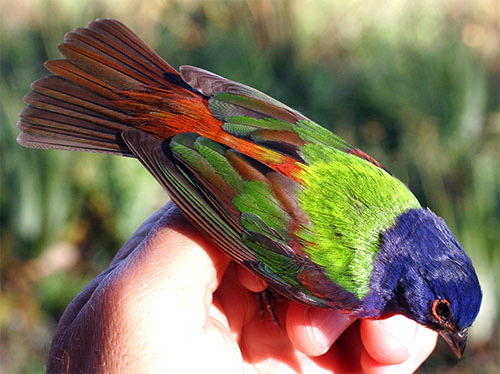
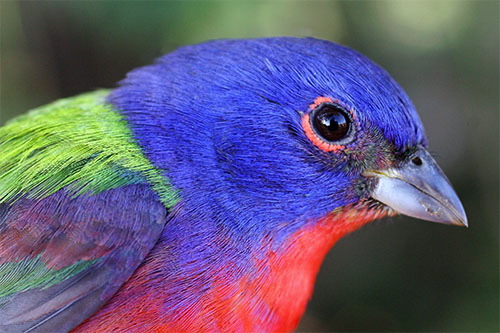
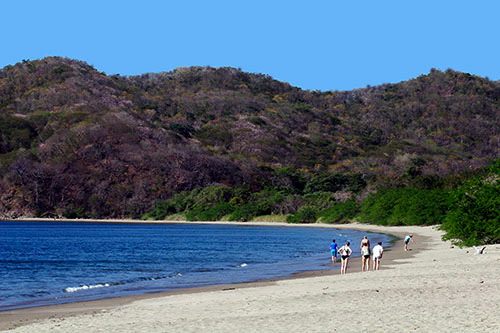
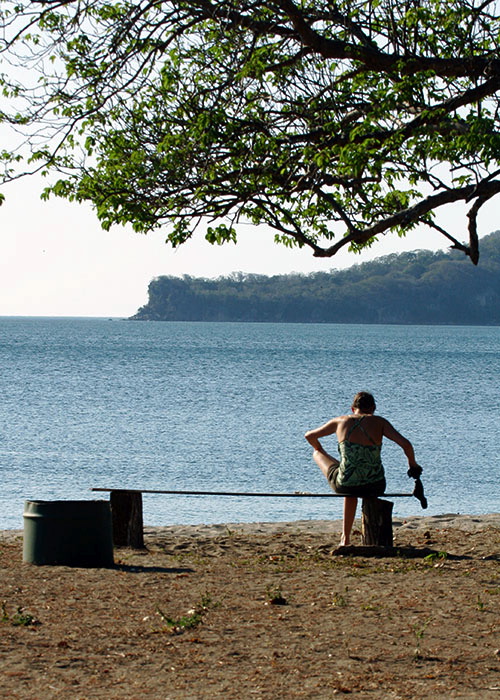
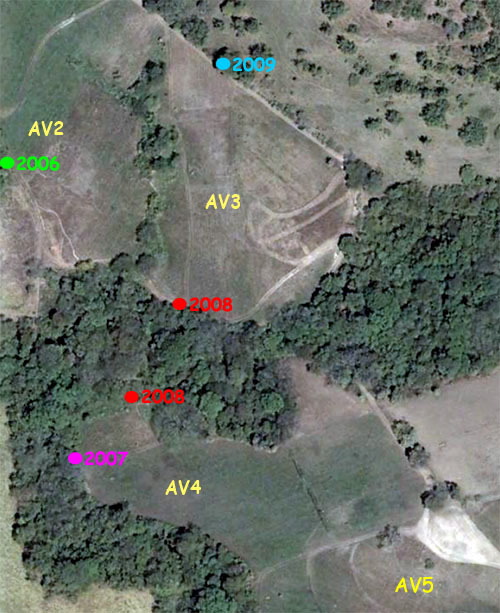
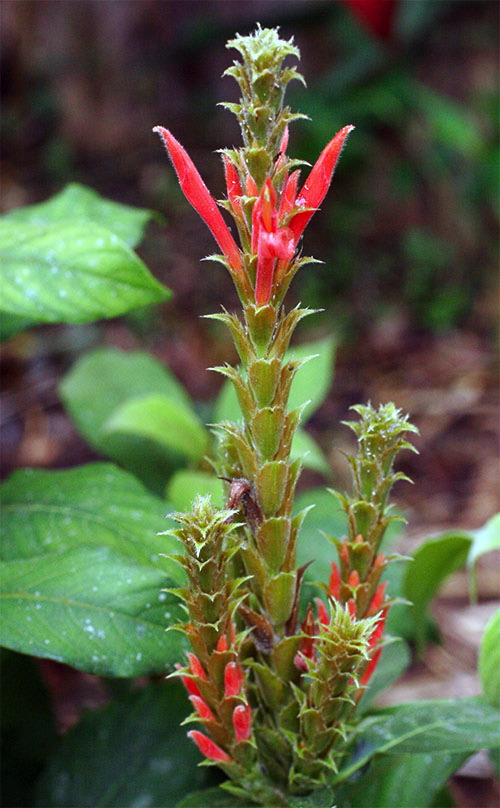
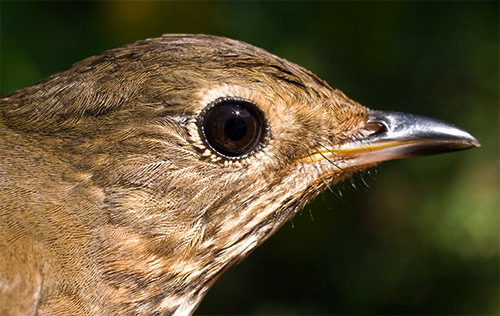
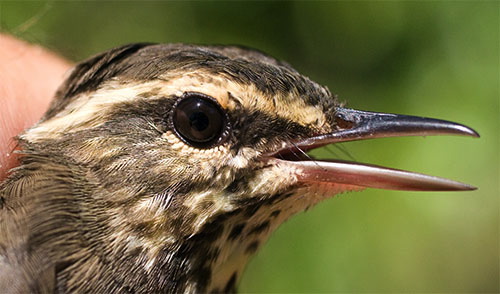
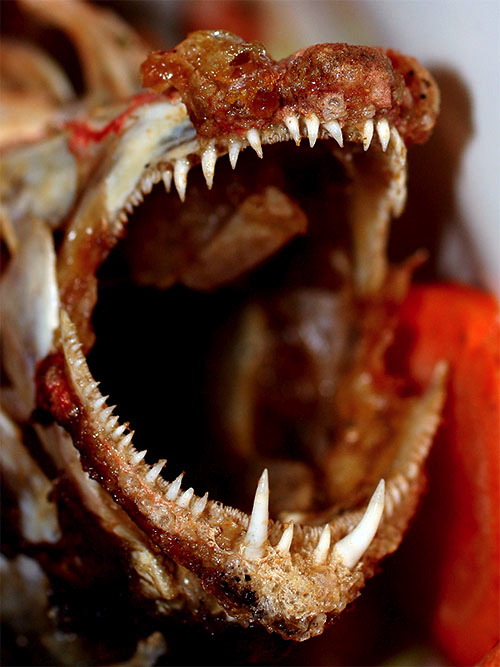
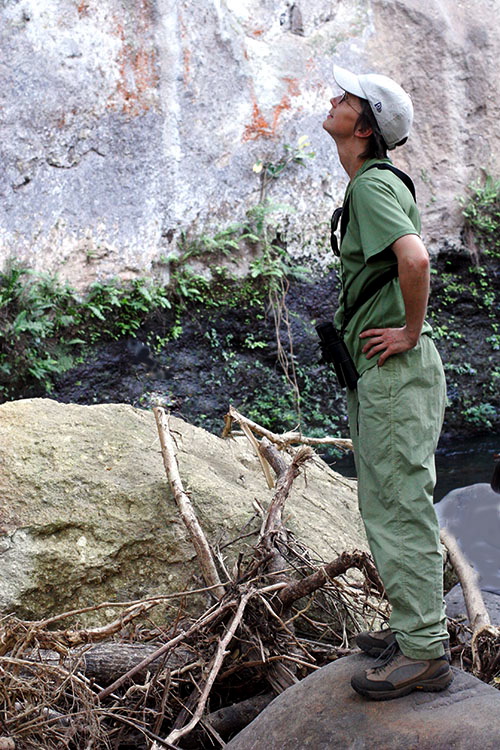
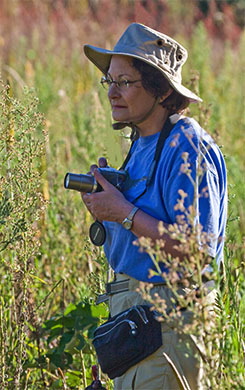 As the sun rose on 10 February, members of Krazy '08s Omega were already up and about on their last morning in Costa Rica. Some were packing, but most were walking around Buena Vista Lodge with binoculars and/or camera (Alexis Dandretta at right), hoping to see one more bird species or trying to capture a digital image of something they had forgotten to photograph. Ernesto, meanwhile, was busily transferring all the field equipment from the bus to his personal car, which we'd been using all week as Fearless Leader's handicap vehicle and that would see even more use during Week Three. The Omega group had one last breakfast in the Lodge's main dining hall--need we say black beans and rice were on the serving line?--and then it was time to load and board Whiskers' bus for a final ride down the mountain.
As the sun rose on 10 February, members of Krazy '08s Omega were already up and about on their last morning in Costa Rica. Some were packing, but most were walking around Buena Vista Lodge with binoculars and/or camera (Alexis Dandretta at right), hoping to see one more bird species or trying to capture a digital image of something they had forgotten to photograph. Ernesto, meanwhile, was busily transferring all the field equipment from the bus to his personal car, which we'd been using all week as Fearless Leader's handicap vehicle and that would see even more use during Week Three. The Omega group had one last breakfast in the Lodge's main dining hall--need we say black beans and rice were on the serving line?--and then it was time to load and board Whiskers' bus for a final ride down the mountain.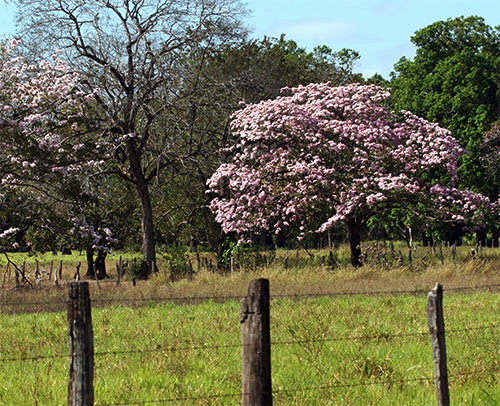
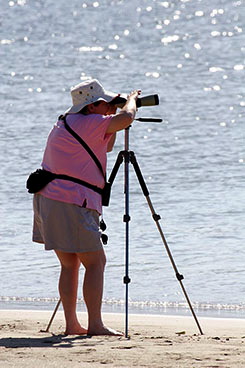 As the bus traveled its final miles, Liz Schmid--the official "trip lister" (left, scoping out birds at Junquillal Beach)--read off an impressive list of nearly 90 bird species the group had seen during the week.
As the bus traveled its final miles, Liz Schmid--the official "trip lister" (left, scoping out birds at Junquillal Beach)--read off an impressive list of nearly 90 bird species the group had seen during the week.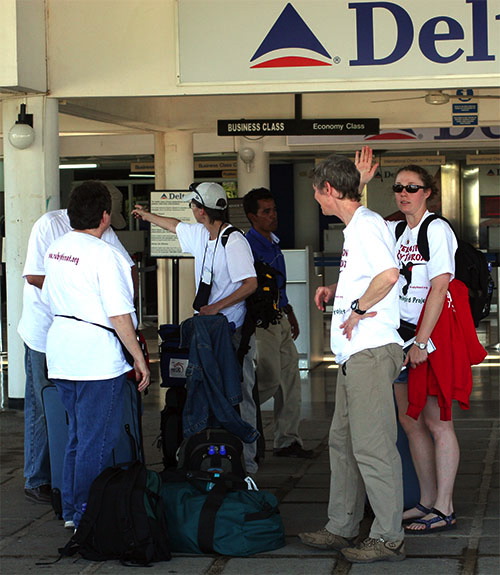
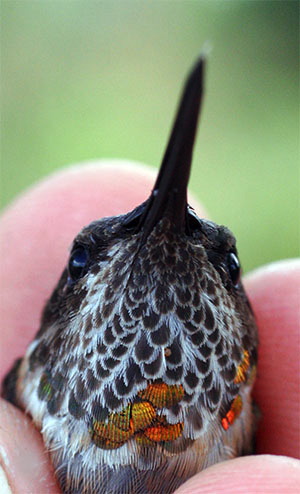 so they were classified as SY or Second Year birds, AKA "juveniles". (The SY male in the photo at right has a partly red gorget and very dark greenish-black streaking on its throat--both signs of a juvenile male.) It should be mentioned that all birds become "a year older" on 1 January.
so they were classified as SY or Second Year birds, AKA "juveniles". (The SY male in the photo at right has a partly red gorget and very dark greenish-black streaking on its throat--both signs of a juvenile male.) It should be mentioned that all birds become "a year older" on 1 January. 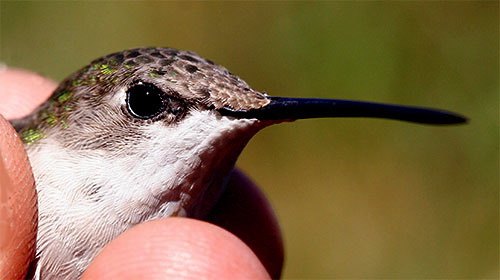
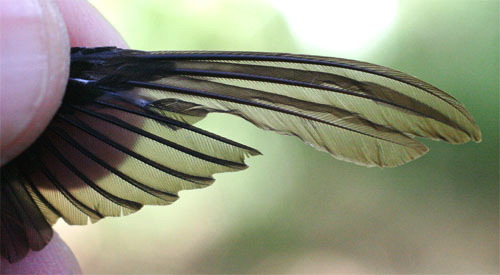
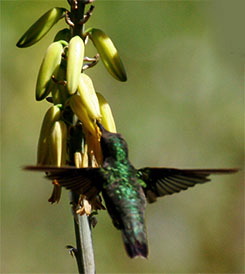 This ratio is considerably different from what we find during the March-through-October banding season at Hilton Pond Center, where the male:female ratios over the past 25 years have been close to 1:1 during spring/fall migration and the breeding season. We're not sure what might cause ratios to be skewed toward males within aloe fields on wintering grounds, but some female RTHU may be foraging elsewhere and there may be other behavioral differences. We expect to return to Costa Rica again next year and duplicate this year's efforts in AV3 and AV4 to see if 2009 results are similar to those from 2008.
This ratio is considerably different from what we find during the March-through-October banding season at Hilton Pond Center, where the male:female ratios over the past 25 years have been close to 1:1 during spring/fall migration and the breeding season. We're not sure what might cause ratios to be skewed toward males within aloe fields on wintering grounds, but some female RTHU may be foraging elsewhere and there may be other behavioral differences. We expect to return to Costa Rica again next year and duplicate this year's efforts in AV3 and AV4 to see if 2009 results are similar to those from 2008.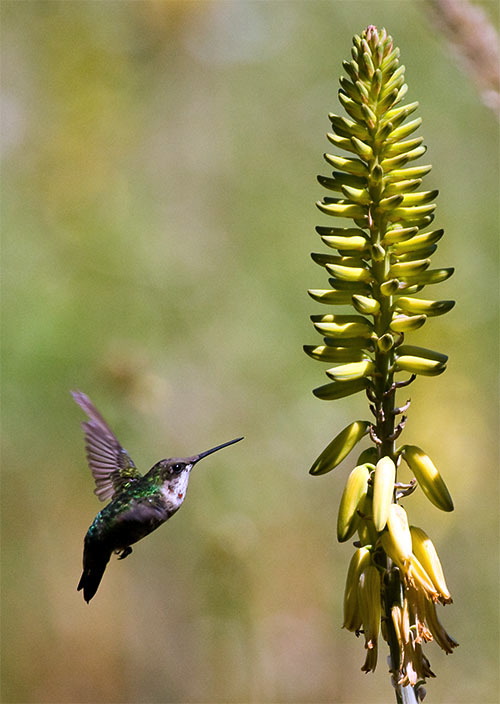
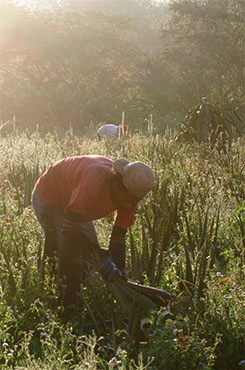 .
.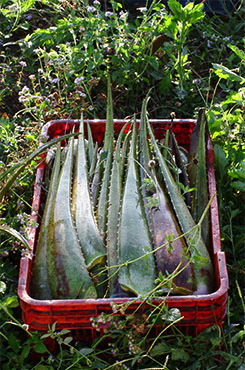
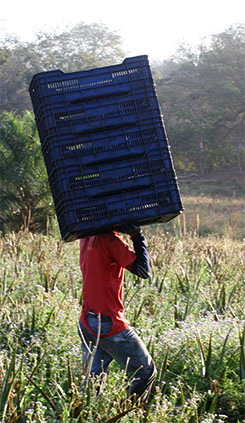 .
.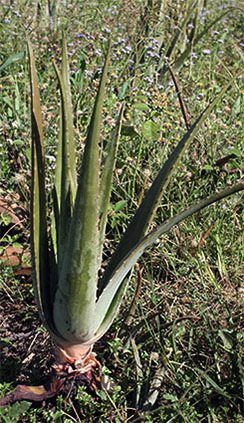
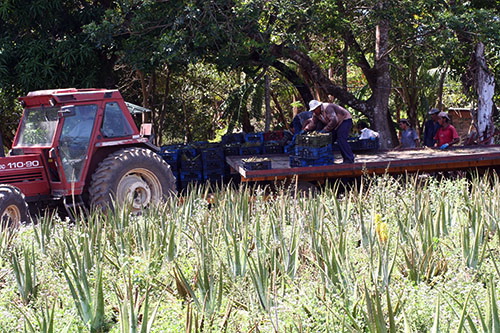
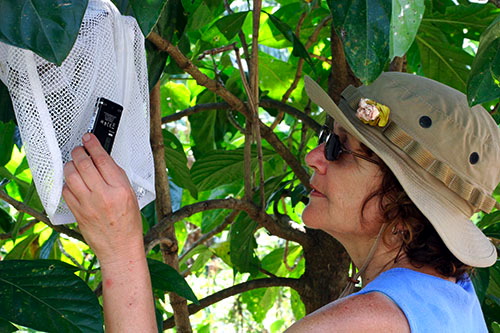
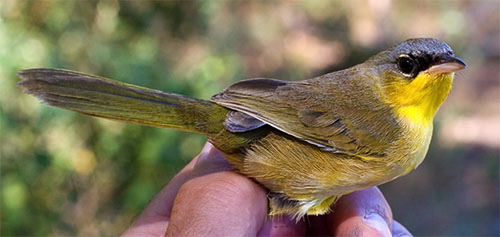
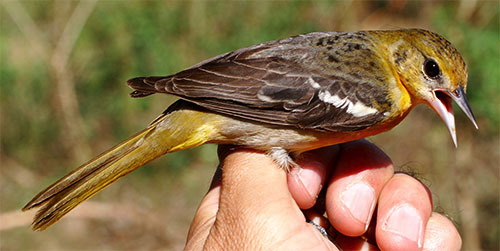
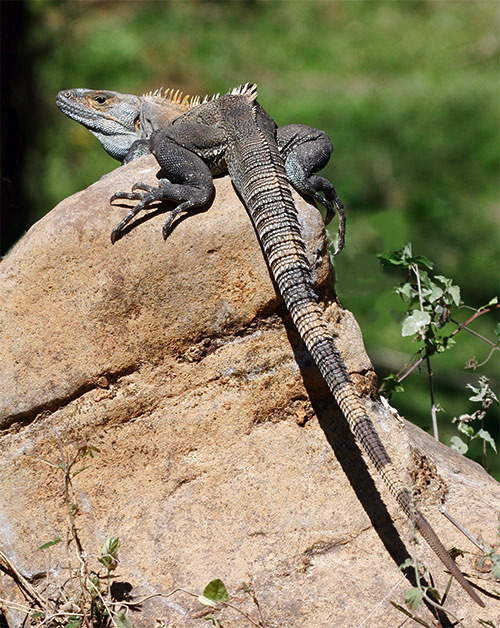
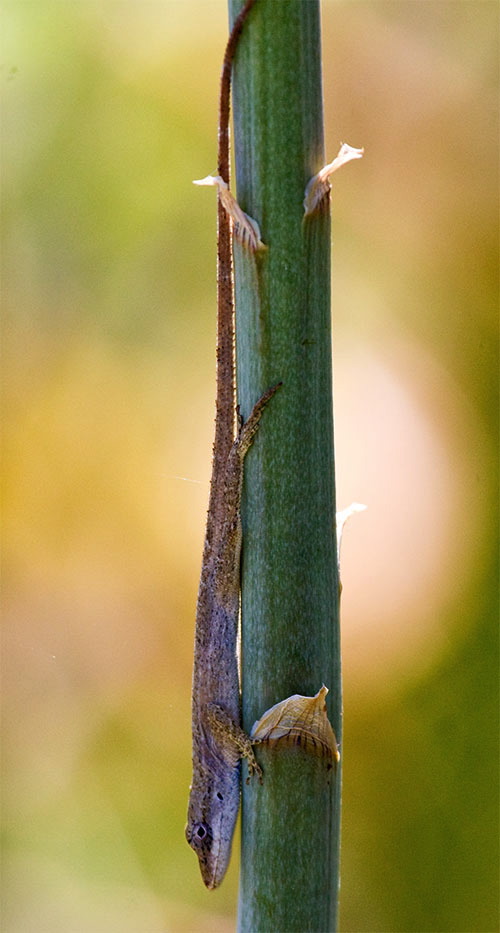
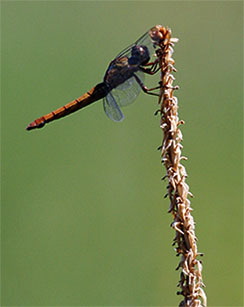 .
. 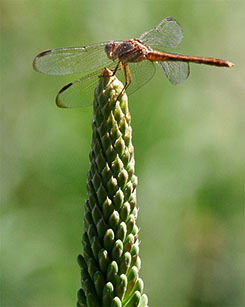
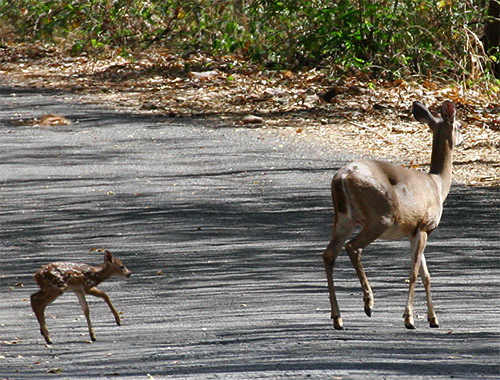
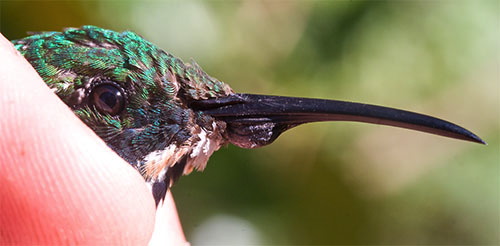
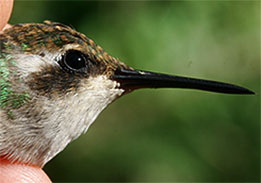 .
.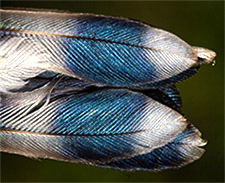

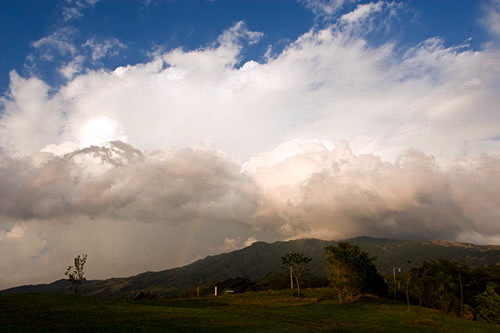
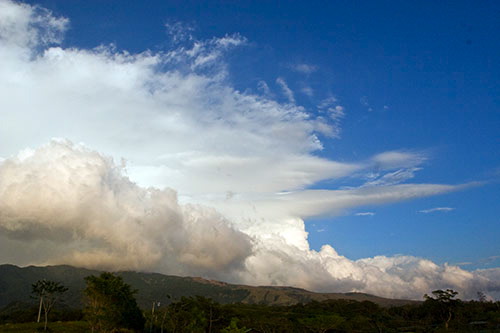
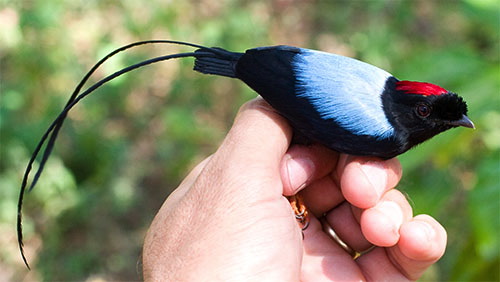
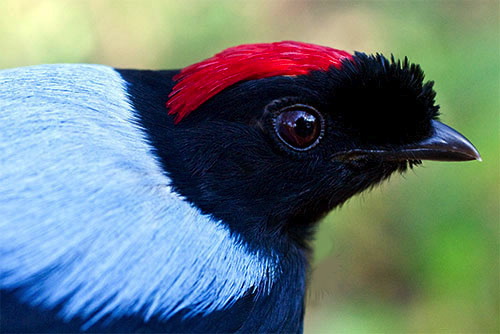
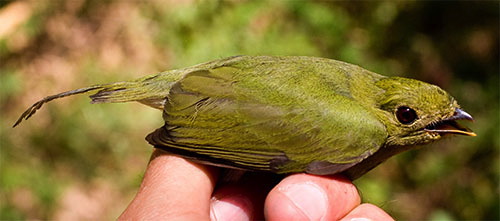
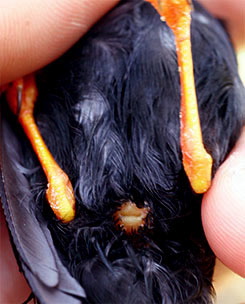
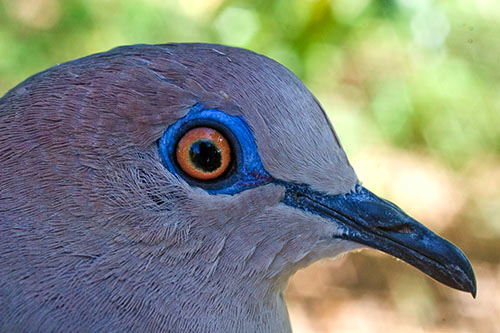
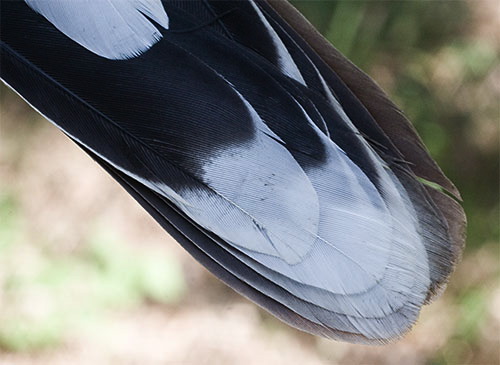
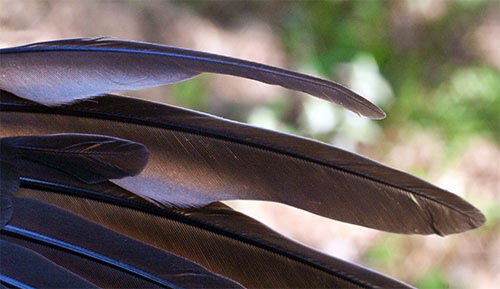

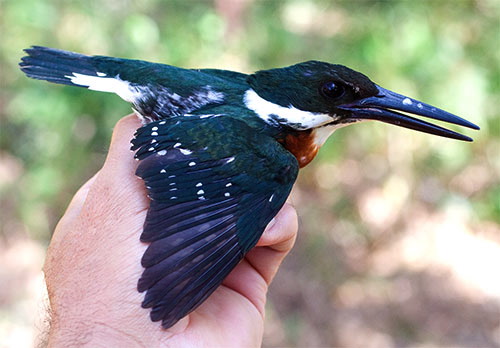
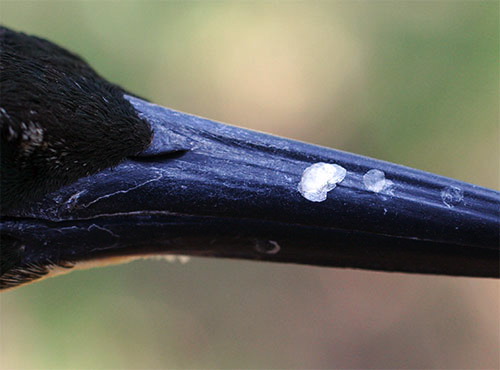
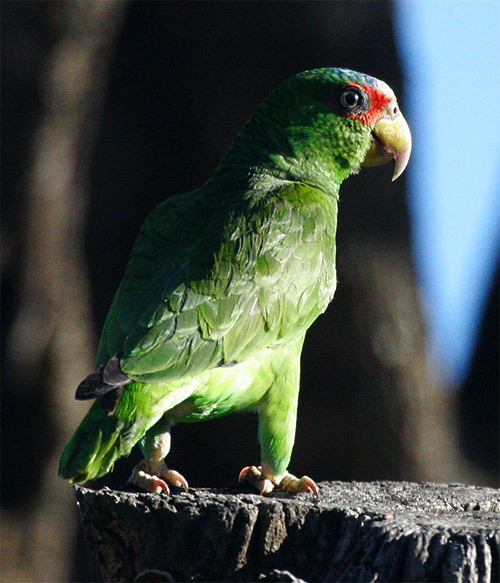
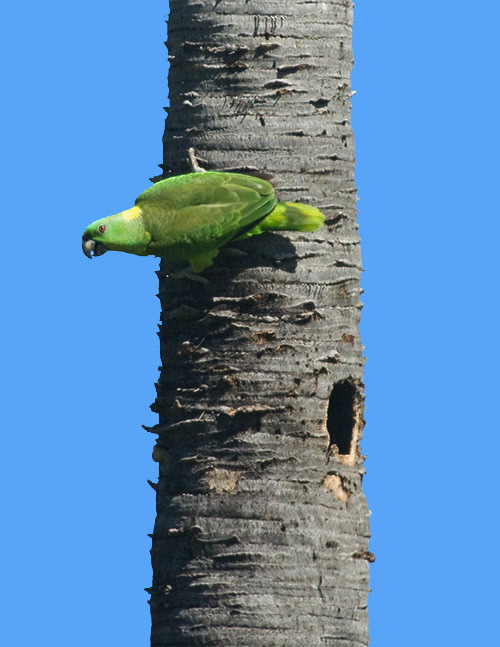
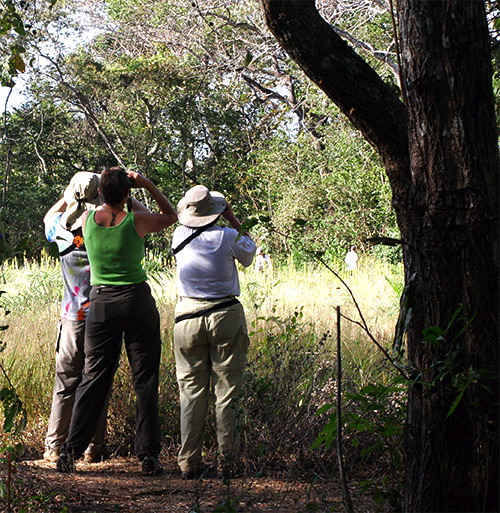
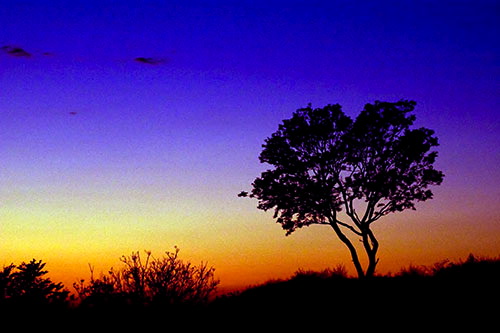



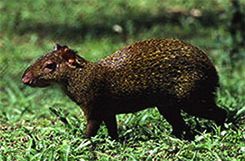
 Oct 15 to Mar 15:
Oct 15 to Mar 15: